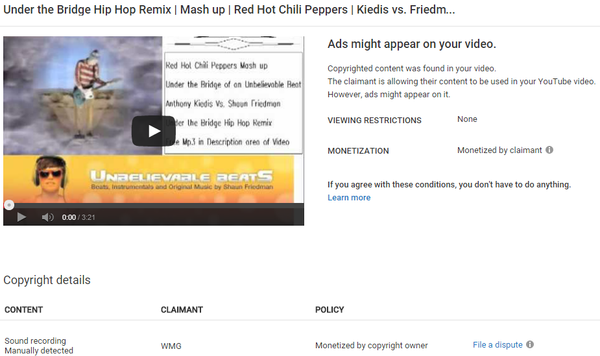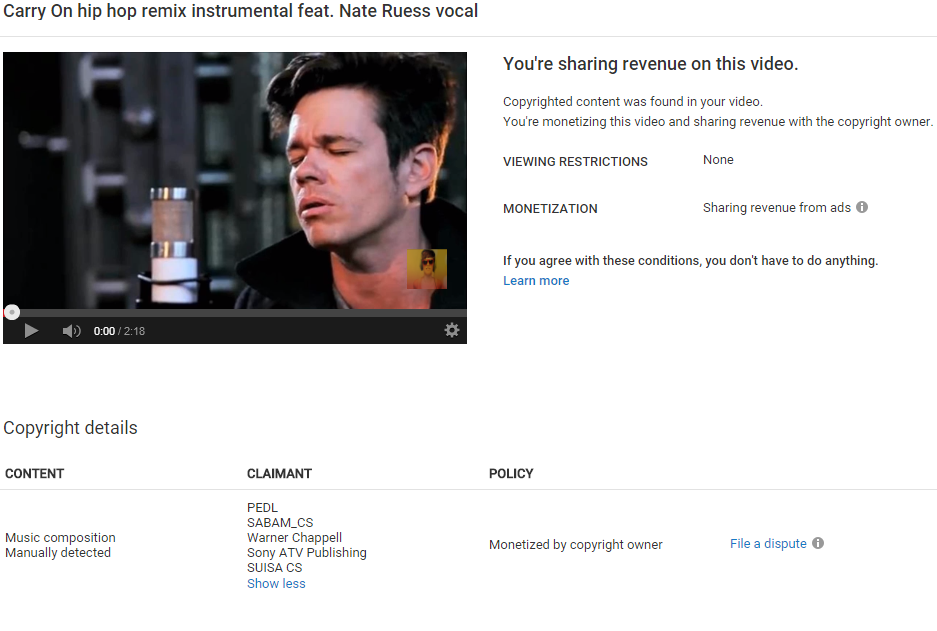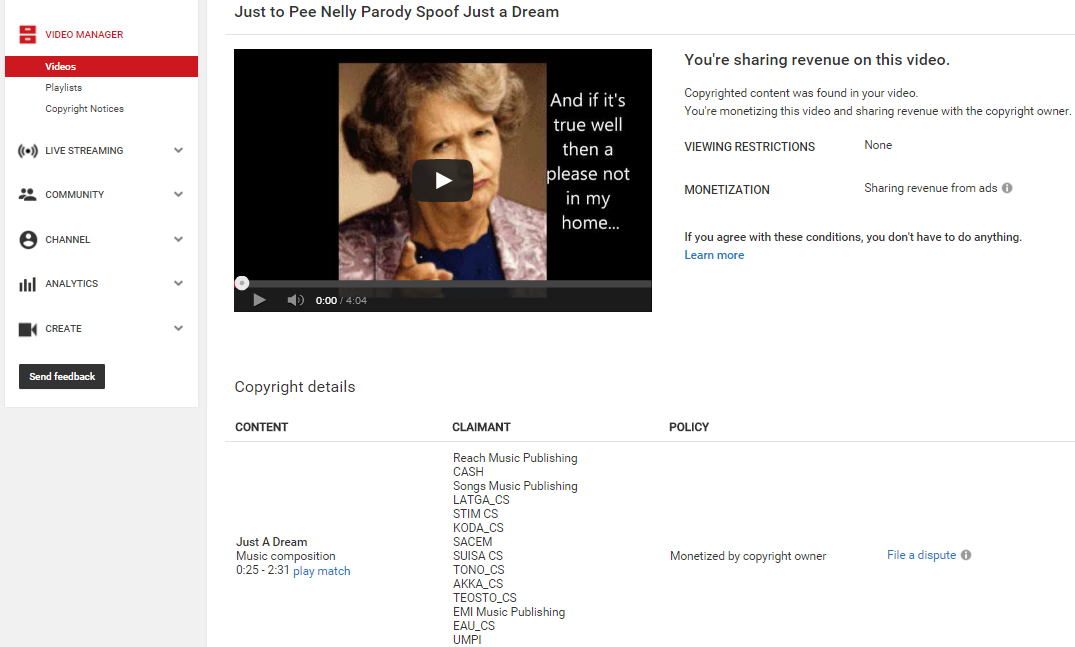The Hows and Whys of Ad Rev and YouTube Content IDWith notes and new opportunities w/ Google "Hosted" Ad Sense because they are all interrelated.Mass Confusion. Irate Musicians. Angry YouTube Channel Owners. Copyright. Infringement. Monetization. Content. Welcome to the internet in the year 2015. This doesn't exactly sound like a fun party, but for good reason. Your ideas are at stake. Your recognition is at stake. Perhaps most importantly, revenue owed to you is at stake.
Personally, I am on the front lines of all of the above, because I have my own YouTube Channel named ShaunFriedman, in addition to having a website that offers beats for downloads, and in addition to having other publishers peddle my instrumental music across the globe. I have seen various claims on some of the videos I upload which include Sound Recording claims and Visual Content claims. YouTube Content ID claims are not just specific to Ad Rev; they are specific to any business or corporation or entity that partners with YouTube Content ID, and generally speaking, can claim copyright on Images, Movie Clips (Audio in the actual movie or the background music in the movie), TV shows, and of course, sound recordings.
This article will focus on the partnership of Ad Rev, YouTube Content ID, and YouTube channel owners/uploaders, though the concepts may be congruent with any entity that works with YouTube Content ID. I'll go through each topic in numbers, covering questions and concerns of music creators and YouTube creators, which often times are the same person, like myself :) YouTube channel owners are also a very important piece of the equation here, because when approved, they can monetize their own videos directly though YouTube Hosted AdSense, not to be confused with YouTube Content ID, but of course.
1.) "Can't I just apply to YouTube's Content ID Directly?" If you ever thought this, congratulations! Way to go directly to the source. After all, why would you need a middle man between yourself and YouTube Content ID? Unfortunately, I have heard rumors that YouTube's Content ID application process has gone dormant and is basically unattainable.
However, this didn't stop me from trying back in August of 2014. My information was successfully submitted directly to YouTube, and they closed their notification by saying "this is a beta program, and we're in an ongoing process of refining, improving, and scaling the system up to meet everyone's needs." All in all, it's probably a long shot to get approved directly, because YouTube works with major players like Warner Bros, Ad Rev, Audiam, CD Baby, Universal Music Group (UMG), Warner Music Group (WMG), and Sony Music Entertainment. (SME) These type of Behemoth companies have the rights to thousands upon thousands of sound recordings and media.
2.) How does Ad Rev work exactly? Ad Rev allows publishers and composers to upload music (music that you are the original owner/publisher/composer/rights holder of) into the Ad Rev system. Then, Ad Rev works directly with YouTube Content ID to find instances where your content is used on YouTube. Ad Rev is strictly a YouTube admin. It's a pretty robust system that will catch you if you use copyrighted material. As a member of Ad Rev, you can also submit DIRECT URLs of YouTube videos that use your music. Once a match is found, the YouTube channel uploader of said video will receive a notice that there is a copyright claim. Refer to below for what happens once there is a claim on your video.
3.) "Why are there claims on my Video?!? Now what!?" It's important to understand why there are claims in the first place. There would be a Content ID match or claim on one of your videos if you used copyrighted material from someone else. As mentioned above, this relates to all media including Images/Visual content, sound recordings, Audio Content (this type of claim happens with major movie publishers/studios), and more.
To avoid having a claim in the first place, you all have to do is make sure every single piece of anything used in your video is an original creation.
When you receive a claim, YouTube sometimes uses threatening language about losing your channel and so on.
You have a couple of choices at this point:
a.) Remove your video
b.) Accept the claim. Accepting the claim means that you NO LONGER can monetize your own video with Google Hosted Ad Sense. The little green money sign that usually is available for you to monetize with Ad Sense will disappear, and the advertising earnings made by your video will go directly to the Claimant. In the below example, Warner Music Group is now monetizing my Under the Bridge Hip Hop Remix. I have no qualms or anger to this because I clearly used audio from the Red Hot Chili Peppers. My YouTube account is still in good standing, and I have over 30 videos that are claimed by other entities. Accepting the claim means are you are Acknowledging third party content. Personally, in relation to the Under the Bridge video, I still list my website link in the description of the video, so at least I'm gaining something from the video. There are many different circumstances and scenarios relating to Copyright Claims and your YouTube channel, and when a particular video has gone "Viral," the ins and outs of all this hold a much greater stake. Maybe, as an actual YouTube channel uploader, you have a video of your Cat making scrambled eggs that has over 2 million views, but if your video uses a song from Elton John, you are now making Universal Music Group money, if you accept the claim and you don't delete your video.
Maybe, as an actual YouTube channel uploader, you have a video of your Cat making scrambled eggs that has over 2 million views, but if your video uses a song from Elton John, you are now making Universal Music Group money, if you accept the claim and you don't delete your video.
In the Cat making scrambled eggs example, if you used background music from YouTube's Audio Library, you would have still been able to monetize your video directly with Google Hosted Ad Sense. This is clearly something all YouTube channel owners should be conscious of, because by the time it's potentially viral, it may be too late to go back and make changes. *However*, some songs affect your own advertising and monetization in various ways, so be sure to read carefully before using a music track. Also, terms can "automatically" change, muddying up the waters further.
Another option is to have an agreement with a song publisher or composer that implicitly states they CANNOT administer or claim the sound recording through YouTube Content ID, because IF they WERE ALLOWED, it would render your own monetization null and void (With Ad Sense) and the composer would be the only person making revenue off your video.
If there ever is a case where you know you agreed (in writing) to use a track without worrying about Content ID, you can provide the written specifics to YouTube, Ad Rev, or any company you are working with, and they can remove the Content ID claim for you.
Generally speaking, when issues arise over Content ID and Ad Rev, Ad Rev can remove claims or a composer or publisher can remove claims for you (by informing Ad Rev), once everyone is in agreement that the claim should truly be removed. This is also referred to as "White Listing" certain videos. You can also dispute claims directly through YouTube.
Ad Rev can also reassign ownership of music tracks. This can only happen if you have a written legal agreement that states why the ownership should change.4.) Licensing and Distribution deals as a composer. When you sign (as a musician/composer) a distribution, licensing, publishing, or Record deal with a 3rd party, make sure you are the only Admin of your content on YouTube. In most contracts, you are granting them administration rights to all media available now or in the future. This means they are going to upload your songs to Ad Rev or Audiam directly!!! (unless they are a Behemoth that works with YouTube Content ID directly)
If they upload directly, you will receive your small cut (if that) after they receive their share directly from Ad Rev. This is true for indie bands, rap, and all genres of music. They might not even tell you about it at all. However, maybe this WAS part of your deal with them and you are comfortable with them collecting from ALL sources. Either way, make sure you are knowledgeable about YouTube Content ID. In a perfect world, you would negotiate terms in a licensing or distribution deal that states YOU ARE THE ONLY ADMIN of YOUR CONTENT ON YouTube. If that isn't an option, make sure you know what percentage you are getting through Content ID proceeds, if the entity you signed with actually tells you they are administering Content ID.
5.) Who pays more for administrating Content ID? Ad Rev or CD Baby?
Administering Content ID:
CD Baby pays out 50% as opposed to the 80% Ad Rev pays out.
CD Baby also offers a total distribution deal where they make your song or album available in a wide range of media, so it's important to weigh the pros and cons of each.
In a perfect world, you would be able to sign CD Baby's distribution deal where they do all the things they already do, with an addendum that states you are the only admin of your content on YouTube.
6.) What pays more? Ad Rev or Google Hosted Ad Sense?What pays more on a YouTube video? Ad Rev or Google Hosted Ad Sense? If you are a composer, YouTube channel creator, and Ad Rev member all at the same time, this question is pretty important to you.
Fundamentally, this is a question of what generates more: an Audio/Visual (standard Hosted AdSense) or a Sound Recording? (remember, accepting a sound recording claim makes you unable to monetize through Ad Sense, but what if the sound recording claim is your own self !?!?)
For example, let's say I post a tutorial about music production on my own YouTube channel that gets relatively popular. At that point, I could monetize directly through YouTube Hosted Ad Sense Monetization. (not to be confused with Content ID)
On the flip side, I could upload a new, original song I made to Ad Rev, embed the song in my tutorial video, and then have Ad Rev claim my own video and earn revenue from the sound recording.YouTube Hosted Ad Sense is referred to as an Audio/Visual asset, and has demonstrated to earn 15% more than a sound recording (Ad Rev or any entity using Content ID) claim.
Per 1000 views on YouTube, a sound recording (Content ID) may generate $1.00
Per 1000 views on YouTube, your standard Google Hosted Ad Sense may generate $1.15
However, Ad Rev and other entities that work with Google have their own Ad Sense account, and there are sometimes higher quality ads through their network. So, it's not totally clear at this juncture. It is possible that a sound recording claim can earn more than a standard Audio Visual (hosted Ad Sense) and vice versa.7.) Multiple songs in a video vs. One Song in Video: YouTube Content IDIf there is simply 1 song in a video, whoever you gave the admin rights to YouTube will be collecting off that song. (with an accepted copyright claim).
If, for example, there are 5 songs in a single video, it potentially could be the same entity collecting, but it could very well be 5 different entities, which in turn will split the ad share from the video.8.) SHARING REVENUE WITH MAJOR BEHEMOTHS!! Remixes and Covers.
New opportunities [Remixes & Covers!!!] through standard Google Hosted Ad Sense and YouTube Content ID!
While Hosted Ad Sense (YouTube monetization settings as a YouTube Channel uploader/owner) usually claims sampled & found material [Found with YouTube CONTENT ID], leaving you with no revenue stake, in some cases, you can actually SHARE revenue with Warner Chappell, Sony ATV, and any large company who partnerships with YouTube Content ID!!
In the picture [clickable] below, my Carry On remix with a Nate Ruess sample [subsequently matched and claimed by YouTube Content ID) has enabled me to Share with claimants below.Monetization info: "You're sharing money generated from ads with the relevant artist or copyright owner."
I don't know why they accepted me to share with them, but as a composer that's pretty damn cool how the internet enabled revenue sharing with major players, and I never asked for permission in the first place. Maybe they're happy that my remix was decent and making them money so they wanted to give me a nod and include me on the action? On the not so glorious flip side, maybe it's just a google controlled ad network revenue setting. It is the use of copyrighted material, so I like to think the behemoths made the decision. Another shared revenue example can be found here, which is an Alanis Morissette remix: https://www.youtube.com/video_copynotice?v=xJ75cTTiWRkNew Opportunities for COVERS on YouTube!!Recently, a Parody I made with my buddy Travis was accepted to Share revenue through Google monetization.
Another shared revenue example can be found here, which is an Alanis Morissette remix: https://www.youtube.com/video_copynotice?v=xJ75cTTiWRkNew Opportunities for COVERS on YouTube!!Recently, a Parody I made with my buddy Travis was accepted to Share revenue through Google monetization.
As a YouTube channel owner, I was looking over the copyright claims, and I found a notification that said:
"Monetize my video. This is my cover of a song written by somebody else. Learn more."
So, it's definitely a cover of Nelly's Just a Dream, which we re-wrote to be "Just to Pee."
Just to Pee: https://www.youtube.com/watch?v=LLOYct7HLtE
9.)
Types of Copyright Claims and examples in Content ID as YouTube channel owner.
Example 1: Claimant was Warner Bros for a beat I made with an Austin Powers sample.
The content claim was "
Visual" as my thumbnail and image throughout the entire video is an Austin Powers picture.
https://www.youtube.com/watch?v=s8p6wV0klY8 -
So, I have successfully made "MC for Warner Bros" money, though I did get to use the sample, direct visitors to my website, gain subscribers, and remain in "good standing" with YouTube.
All in all, content ID really does protect creators. Nothing bad happened to be nor my channel.
Example 2: A Biggie and 2pac Remix I composed and uploaded on my channel was Claimed by UMG [Universal Music Group], and was Blocked in Some Countries, the "some" which was only 1 country; Germany.
https://www.youtube.com/watch?v=SBDu1H5R7yAI am unsure of what is actually claimed as I used verses from Biggie and Pac in "Runnin' (Dying to Live)" yet used a different instrumental.
Example 3: 2pac and Eminem Remix:
https://www.youtube.com/watch?v=IxZv8O5QQck - The Copyright claimant is "UMG" [Universal Music Group]
who matched with "Only Fear of Death - 2pac" - sound recording. This happened to be blocked only in Germany. In this example, the Content ID system identified 2pac, which has an acapella I used.
It does not appear as though the Content ID System caught my use of the instrumental "I'm not Afraid" by Eminem.
As you can see, there are many pieces and parts of the Google Content ID System. Each case is different because there many varying terms of agreements, many copyright owners, many YouTube channel uploaders, and many creative photographers and composers. Though people are frustrated about copyright claims, at its heart the system is truly trying to protect rights holders.



